check engine light FORD E SERIES 2002 4.G Owners Manual
[x] Cancel search | Manufacturer: FORD, Model Year: 2002, Model line: E SERIES, Model: FORD E SERIES 2002 4.GPages: 272, PDF Size: 2.6 MB
Page 14 of 272
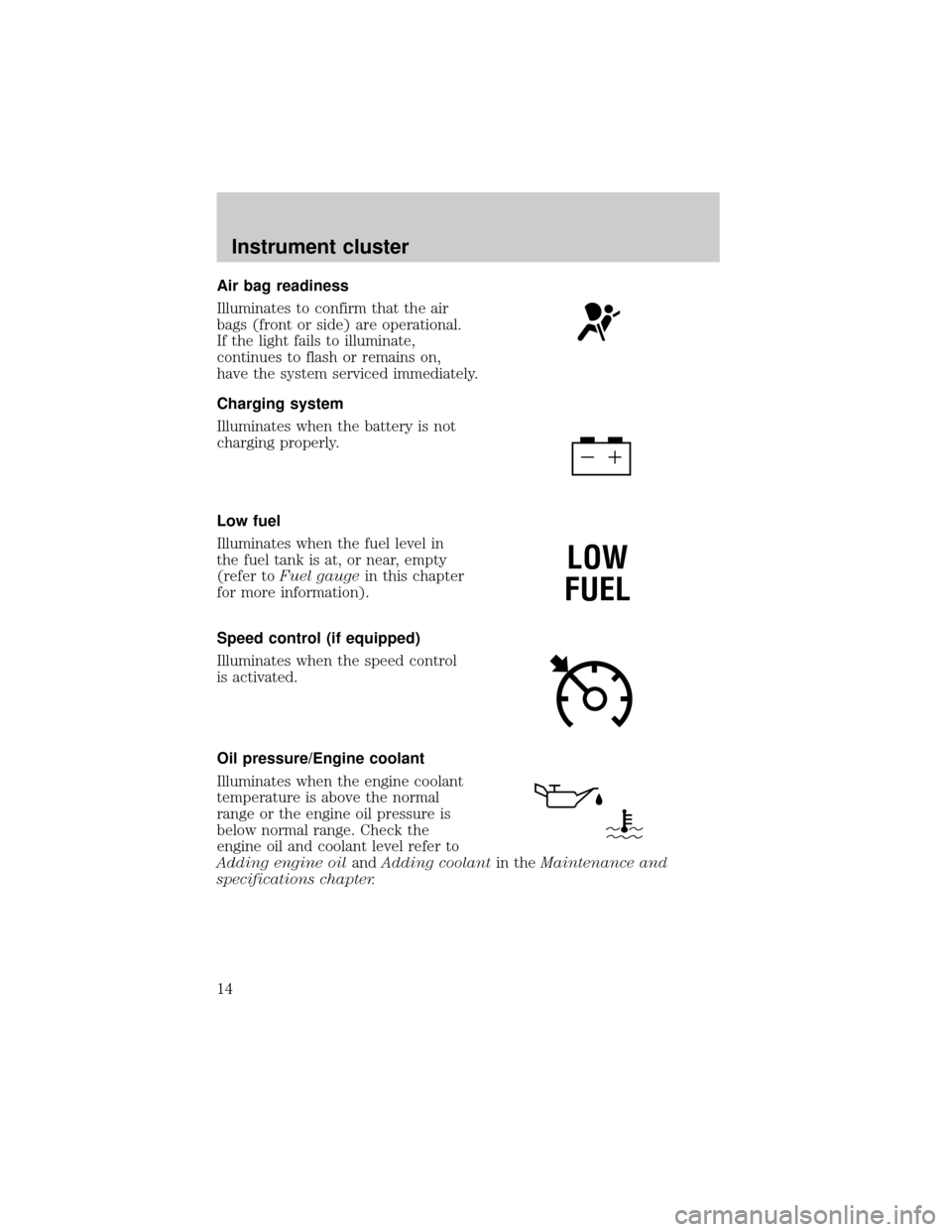
Air bag readiness
Illuminates to confirm that the air
bags (front or side) are operational.
If the light fails to illuminate,
continues to flash or remains on,
have the system serviced immediately.
Charging system
Illuminates when the battery is not
charging properly.
Low fuel
Illuminates when the fuel level in
the fuel tank is at, or near, empty
(refer toFuel gaugein this chapter
for more information).
Speed control (if equipped)
Illuminates when the speed control
is activated.
Oil pressure/Engine coolant
Illuminates when the engine coolant
temperature is above the normal
range or the engine oil pressure is
below normal range. Check the
engine oil and coolant level refer to
Adding engine oilandAdding coolantin theMaintenance and
specifications chapter.
LOW
FUEL
Instrument cluster
14
Page 214 of 272
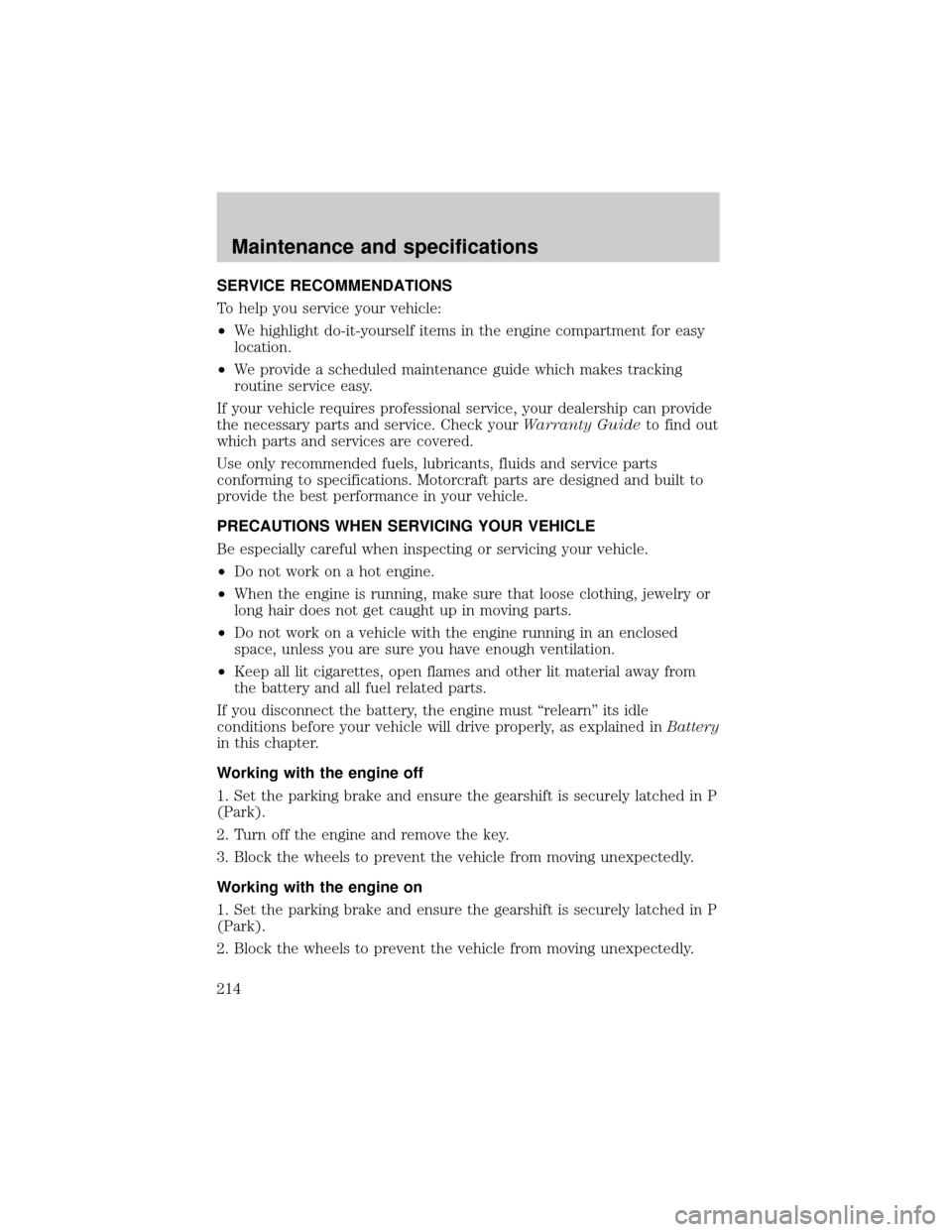
SERVICE RECOMMENDATIONS
To help you service your vehicle:
²We highlight do-it-yourself items in the engine compartment for easy
location.
²We provide a scheduled maintenance guide which makes tracking
routine service easy.
If your vehicle requires professional service, your dealership can provide
the necessary parts and service. Check yourWarranty Guideto find out
which parts and services are covered.
Use only recommended fuels, lubricants, fluids and service parts
conforming to specifications. Motorcraft parts are designed and built to
provide the best performance in your vehicle.
PRECAUTIONS WHEN SERVICING YOUR VEHICLE
Be especially careful when inspecting or servicing your vehicle.
²Do not work on a hot engine.
²When the engine is running, make sure that loose clothing, jewelry or
long hair does not get caught up in moving parts.
²Do not work on a vehicle with the engine running in an enclosed
space, unless you are sure you have enough ventilation.
²Keep all lit cigarettes, open flames and other lit material away from
the battery and all fuel related parts.
If you disconnect the battery, the engine must ªrelearnº its idle
conditions before your vehicle will drive properly, as explained inBattery
in this chapter.
Working with the engine off
1. Set the parking brake and ensure the gearshift is securely latched in P
(Park).
2. Turn off the engine and remove the key.
3. Block the wheels to prevent the vehicle from moving unexpectedly.
Working with the engine on
1. Set the parking brake and ensure the gearshift is securely latched in P
(Park).
2. Block the wheels to prevent the vehicle from moving unexpectedly.
Maintenance and specifications
214
Page 217 of 272
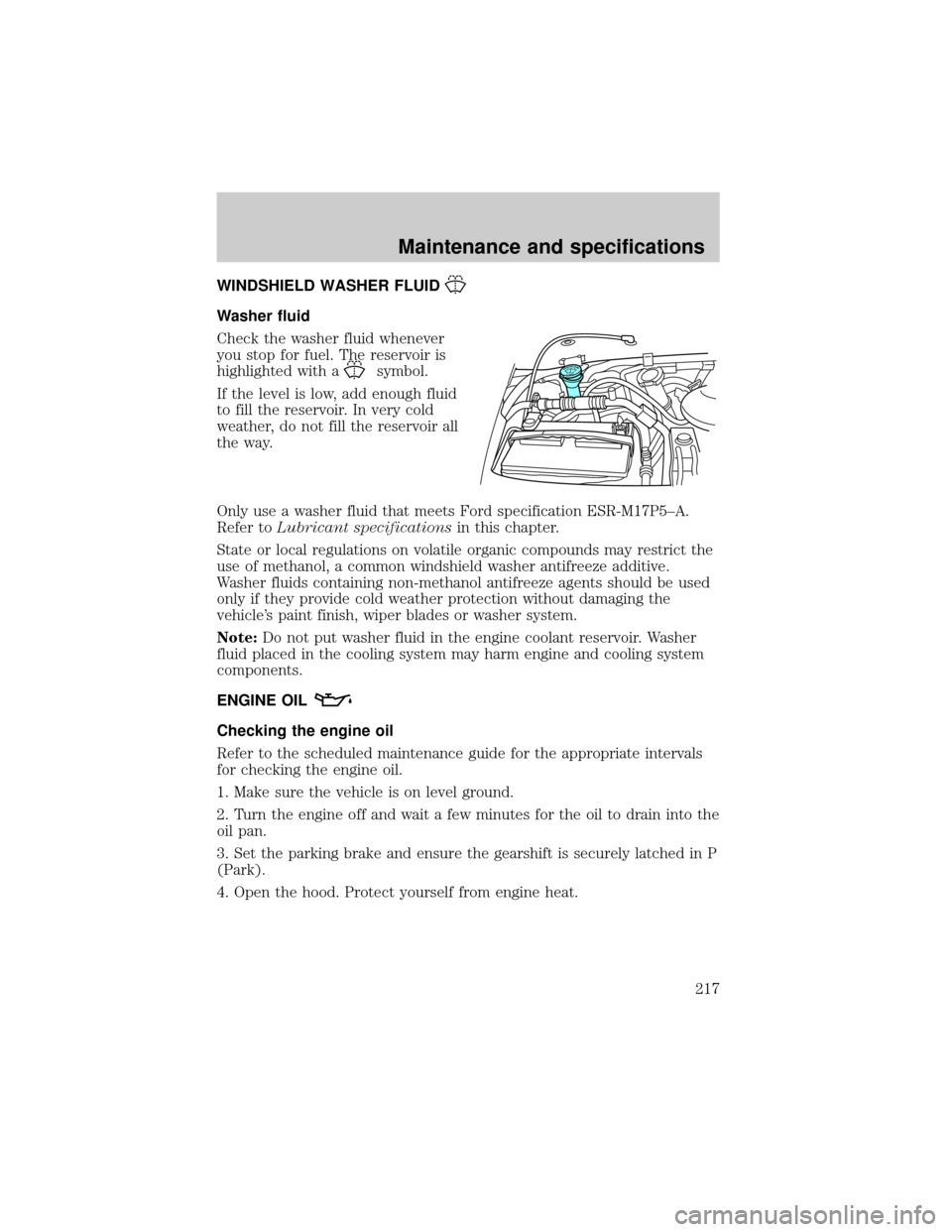
WINDSHIELD WASHER FLUID
Washer fluid
Check the washer fluid whenever
you stop for fuel. The reservoir is
highlighted with a
symbol.
If the level is low, add enough fluid
to fill the reservoir. In very cold
weather, do not fill the reservoir all
the way.
Only use a washer fluid that meets Ford specification ESR-M17P5±A.
Refer toLubricant specificationsin this chapter.
State or local regulations on volatile organic compounds may restrict the
use of methanol, a common windshield washer antifreeze additive.
Washer fluids containing non-methanol antifreeze agents should be used
only if they provide cold weather protection without damaging the
vehicle's paint finish, wiper blades or washer system.
Note:Do not put washer fluid in the engine coolant reservoir. Washer
fluid placed in the cooling system may harm engine and cooling system
components.
ENGINE OIL
Checking the engine oil
Refer to the scheduled maintenance guide for the appropriate intervals
for checking the engine oil.
1. Make sure the vehicle is on level ground.
2. Turn the engine off and wait a few minutes for the oil to drain into the
oil pan.
3. Set the parking brake and ensure the gearshift is securely latched in P
(Park).
4. Open the hood. Protect yourself from engine heat.
Maintenance and specifications
217
Page 229 of 272
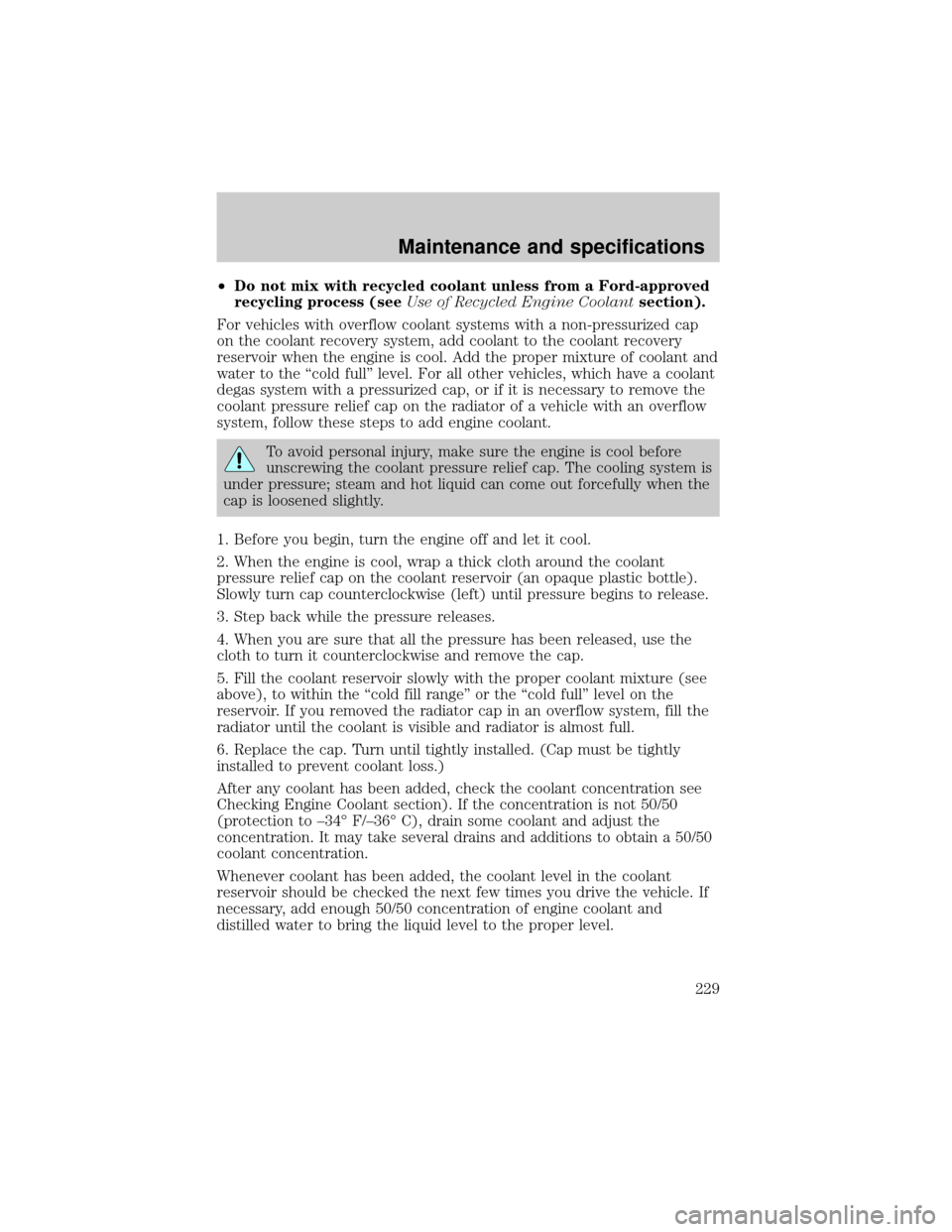
²Do not mix with recycled coolant unless from a Ford-approved
recycling process (seeUse of Recycled Engine Coolantsection).
For vehicles with overflow coolant systems with a non-pressurized cap
on the coolant recovery system, add coolant to the coolant recovery
reservoir when the engine is cool. Add the proper mixture of coolant and
water to the ªcold fullº level. For all other vehicles, which have a coolant
degas system with a pressurized cap, or if it is necessary to remove the
coolant pressure relief cap on the radiator of a vehicle with an overflow
system, follow these steps to add engine coolant.
To avoid personal injury, make sure the engine is cool before
unscrewing the coolant pressure relief cap. The cooling system is
under pressure; steam and hot liquid can come out forcefully when the
cap is loosened slightly.
1. Before you begin, turn the engine off and let it cool.
2. When the engine is cool, wrap a thick cloth around the coolant
pressure relief cap on the coolant reservoir (an opaque plastic bottle).
Slowly turn cap counterclockwise (left) until pressure begins to release.
3. Step back while the pressure releases.
4. When you are sure that all the pressure has been released, use the
cloth to turn it counterclockwise and remove the cap.
5. Fill the coolant reservoir slowly with the proper coolant mixture (see
above), to within the ªcold fill rangeº or the ªcold fullº level on the
reservoir. If you removed the radiator cap in an overflow system, fill the
radiator until the coolant is visible and radiator is almost full.
6. Replace the cap. Turn until tightly installed. (Cap must be tightly
installed to prevent coolant loss.)
After any coolant has been added, check the coolant concentration see
Checking Engine Coolant section). If the concentration is not 50/50
(protection to ±34É F/±36É C), drain some coolant and adjust the
concentration. It may take several drains and additions to obtain a 50/50
coolant concentration.
Whenever coolant has been added, the coolant level in the coolant
reservoir should be checked the next few times you drive the vehicle. If
necessary, add enough 50/50 concentration of engine coolant and
distilled water to bring the liquid level to the proper level.
Maintenance and specifications
229
Page 242 of 272
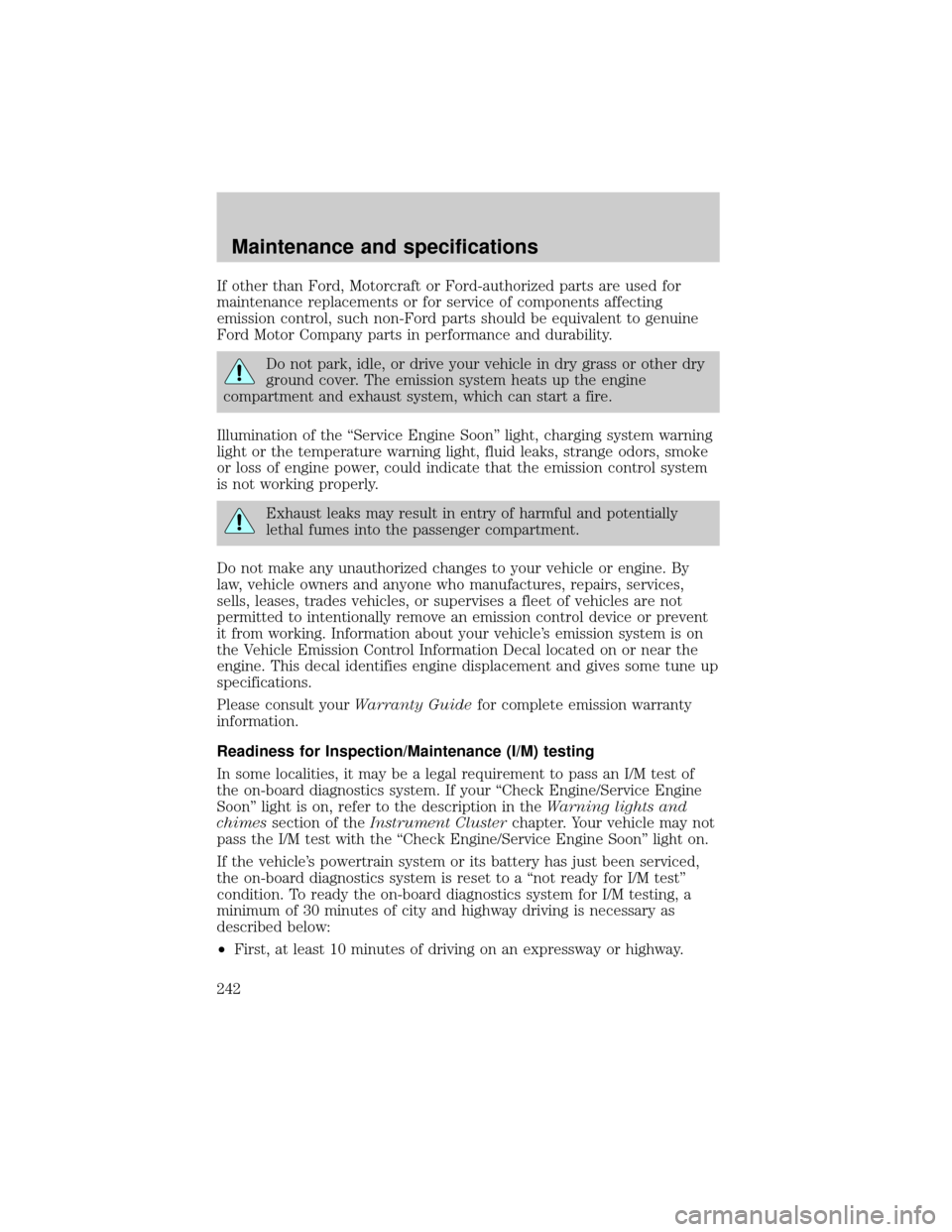
If other than Ford, Motorcraft or Ford-authorized parts are used for
maintenance replacements or for service of components affecting
emission control, such non-Ford parts should be equivalent to genuine
Ford Motor Company parts in performance and durability.
Do not park, idle, or drive your vehicle in dry grass or other dry
ground cover. The emission system heats up the engine
compartment and exhaust system, which can start a fire.
Illumination of the ªService Engine Soonº light, charging system warning
light or the temperature warning light, fluid leaks, strange odors, smoke
or loss of engine power, could indicate that the emission control system
is not working properly.
Exhaust leaks may result in entry of harmful and potentially
lethal fumes into the passenger compartment.
Do not make any unauthorized changes to your vehicle or engine. By
law, vehicle owners and anyone who manufactures, repairs, services,
sells, leases, trades vehicles, or supervises a fleet of vehicles are not
permitted to intentionally remove an emission control device or prevent
it from working. Information about your vehicle's emission system is on
the Vehicle Emission Control Information Decal located on or near the
engine. This decal identifies engine displacement and gives some tune up
specifications.
Please consult yourWarranty Guidefor complete emission warranty
information.
Readiness for Inspection/Maintenance (I/M) testing
In some localities, it may be a legal requirement to pass an I/M test of
the on-board diagnostics system. If your ªCheck Engine/Service Engine
Soonº light is on, refer to the description in theWarning lights and
chimessection of theInstrument Clusterchapter. Your vehicle may not
pass the I/M test with the ªCheck Engine/Service Engine Soonº light on.
If the vehicle's powertrain system or its battery has just been serviced,
the on-board diagnostics system is reset to a ªnot ready for I/M testº
condition. To ready the on-board diagnostics system for I/M testing, a
minimum of 30 minutes of city and highway driving is necessary as
described below:
²First, at least 10 minutes of driving on an expressway or highway.
Maintenance and specifications
242
Page 267 of 272

A
Air bag supplemental restraint
system ........................................132
and child safety seats ............134
description ..............................132
disposal ....................................137
driver air bag ..........................135
indicator light ...................14, 136
operation .................................135
passenger air bag ...................135
Air cleaner filter ...............247, 253
Air conditioning
manual heating and air
conditioning system .................79
Ambulance packages ....................7
Antifreeze (see Engine
coolant) .....................................226
Anti-lock brake system (see
Brakes) ..............................152±153
Audio system (see Radio) ...20, 41
Automatic transmission
driving an automatic
overdrive .................................157
fluid, adding ............................245
fluid, checking ........................245
fluid, refill capacities ..............254
fluid, specification ..................260
Auxiliary power point .................96
Axle
lubricant specifications ..258, 260
refill capacities ........................254
traction lok ..............................155
B
Battery .......................................220
acid, treating emergencies .....220charging system warning light 14
disconnecting ..........................222
jumping a disabled battery ....191
maintenance-free ....................220
replacement, specifications ...253
servicing ..................................220
voltage gauge ............................18
Belt minder ...............................127
Brakes ........................................152
anti-lock ...........................152±153
anti-lock brake system (ABS)
warning light .....................13, 153
brake warning light ..................13
fluid, checking and adding ....244
fluid, refill capacities ..............254
fluid, specifications .........258, 260
lubricant specifications ..258, 260
shift interlock ..........................156
Break-in period .............................5
C
Capacities for refilling fluids ....254
Child safety restraints ..............138
child safety belts ....................138
Child safety seats ......................139
in front seat ............................140
in rear seat ..............................140
tether anchorage hardware ...143
Cleaning your vehicle
engine compartment ..............209
exterior ....................................212
instrument cluster lens ..........211
instrument panel ....................211
interior .....................................211
plastic parts ............................210
safety belts ..............................212
washing ....................................207
waxing .....................................207
Index
267
Page 268 of 272

wheels ......................................208
windows ..................................212
wiper blades ............................210
Clock ..........................23, 28, 37, 45
Compass, electronic ..................104
calibration ...............................106
set zone adjustment ...............105
Console
overhead ..........................102±103
Controls
power seat ...............................114
Coolant
checking and adding ..............226
refill capacities ................230, 254
specifications ..................258, 260
Cruise control (see Speed
control) ........................................98
Customer Assistance ................173
Ford accessories for your
vehicle .....................................212
Ford Extended Service Plan .199
Getting assistance outside the
U.S. and Canada .....................203
Getting roadside assistance ...173
Getting the service you
need .........................................197
Ordering additional owner's
literature .................................204
The Dispute Settlement
Board .......................................200
Utilizing the
Mediation/Arbitration
Program ...................................203
D
Daytime running lamps (see
Lamps) .........................................85Dipstick
automatic transmission fluid .245
engine oil .................................217
Doors
door ajar warning .....................15
lubricant specifications ..........258
Driveline universal joint and
slip yoke ....................................245
Driving under special
conditions
through water .........................160
E
Emergencies, roadside
jump-starting ..........................191
Emission control system ..........241
Engine ................................260±261
check engine/service engine
soon light ..................................12
cleaning ...................................209
coolant .....................................226
diesel ...........................................6
fail-safe coolant ......................231
idle speed control ...................220
lubrication specifications ......258,
260
refill capacities ........................254
service points ..........................216
starting after a collision .........175
Engine block heater .................151
Engine oil ..................................217
checking and adding ..............217
dipstick ....................................217
filter, specifications ........219, 253
recommendations ...................219
refill capacities ........................254
specifications ..................258, 260
Index
268
Page 270 of 272

I
Ignition .......................148, 260±261
Infant seats
(see Safety seats) .....................139
Inspection/maintenance (I/M)
testing ........................................242
Instrument panel
cleaning ...................................211
cluster ................................12, 211
lighting up panel and
interior .......................................86
J
Jack ............................................184
positioning ...............................184
storage .....................................184
Jump-starting your vehicle ......191
K
Keys
key in ignition chime ...............16
positions of the ignition .........148
L
Lamps
bulb replacement
specifications chart ..................88
cargo lamps ...............................86
daytime running light ...............85
headlamps .................................85
headlamps, flash to pass ..........86
instrument panel, dimming .....86
interior lamps ...........................87
replacing bulbs ...................88±93
Lane change indicator (see
Turn signal) .................................86Lights, warning and indicator ....12
air bag ........................................14
anti-lock brakes (ABS) ....13, 153
brake ..........................................13
charging system ........................14
check coolant ............................14
cruise indicator .........................14
door ajar ....................................15
engine oil pressure ...................14
high beam .................................15
low fuel ......................................14
safety belt .................................13
service engine soon ..................12
turn signal indicator .................15
Load limits .................................160
GAWR ......................................160
GVWR ......................................160
trailer towing ..........................160
Loading instructions .................162
Lubricant specifications ...258, 260
Lumbar support, seats .............114
M
Mirrors
fold away ...................................98
side view mirrors (power) .......97
Motorcraft parts ................238, 253
O
Octane rating ............................236
Odometer .....................................19
Oil (see Engine oil) ..................217
Overdrive ...................................102
Index
270